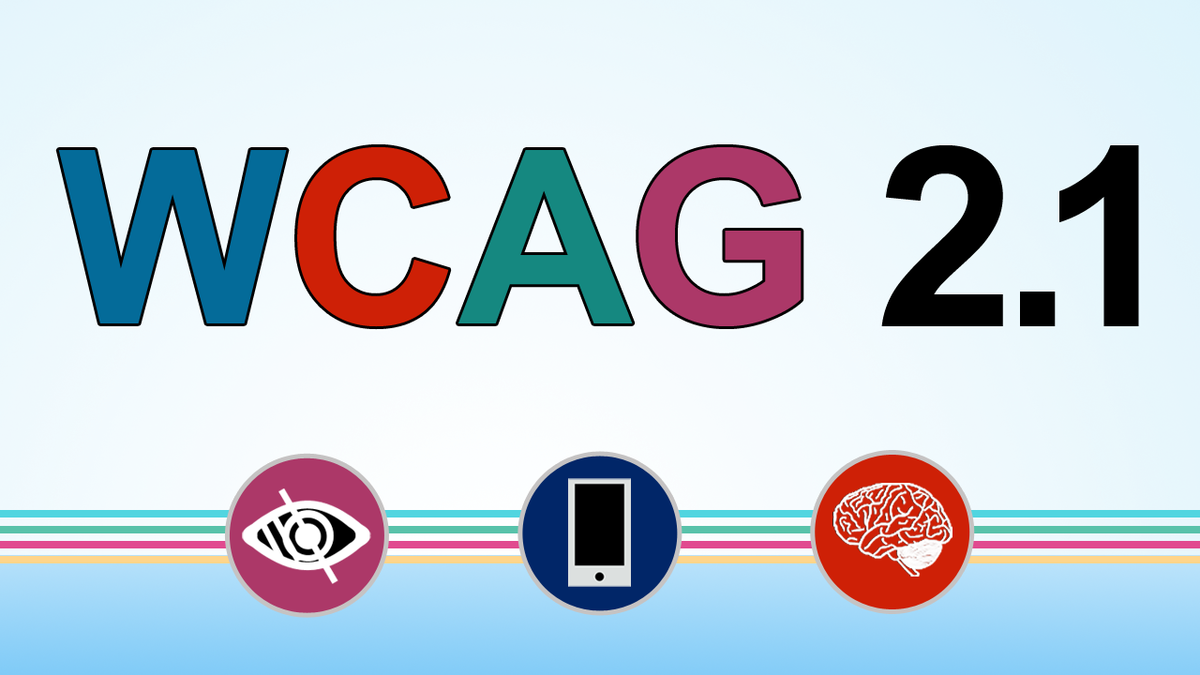On June 5, 2018, Web Content Accessibility Guidelines (WCAG) 2.1 became a World Wide Web Consortium (W3C) Recommendation. The new standard is the first update since WCAG 2.0 became an official W3C Recommendation in 2008. Around 100 people worldwide were involved in 2.1's creation.
WCAG is University of Minnesota Accessibility Policy
WCAG 2.0 AA has been the University of Minnesota accessibility standard since January 2014 as announced in an ITSS newsletter article.
The W3C encourages use of the most current version of WCAG when developing or updating web accessibility policies. The University of Minnesota Accessibility policy is currently under revision.
Backwards Compatible
WCAG 2.1 extends 2.0. Content that conforms to WCAG 2.1 also conforms to WCAG 2.0. This is often called "backwards compatible". Therefore, a website that meets WCAG 2.1 should meet the requirements of policies that reference WCAG 2.0. As previously announced 2.1 adds new Success Criteria (SC) to help address gaps in WCAG 2.0.
What's New in 2.1?
17 new Success Criteria help address content viewed on small display sizes and used with touch and stylus-based input modalities. In addition, new SCs help address the needs of people with low vision, cognitive disabilities, and others.
| SC | Level | Short Explanation | Who is Helped? | Details |
|---|---|---|---|---|
| Orientation | AA | Don't restrict content to solely a landscape or portrait position. | People with dexterity disabilities who have their device mounted, or who cannot change orientation and people with low vision | Understanding Orientation |
| Identify Input Purpose | AA | Make the meaning of common form inputs available with technology. e.g. using autocomplete. | People with cognitive and motor disabilities | Understanding Identify Input Purpose |
| Identify Purpose | AAA | Make the meaning of all controls (not just form inputs) available with technology. | People with cognitive disabilities, low vision, and others who need to personalize their interface | Understanding Identify Purpose |
| Reflow | AA | Make sure content can be enlarged without requiring horizontal scrolling. Content needs to wrap to fit the width of the window. | People with low vision | Understanding Reflow |
| Non-Text Contrast | AA | Make sure important visual information meets the same minimum contrast that is required for larger text. | People who need help seeing or perceiving information in graphics, interactive components, and focus indicators | Understanding Non-text Contrast |
| Text Spacing | AA | Allow for spacing that may be a little spread out. | People with dyslexia and people with low vision who utilize user style sheets. | Understanding Text Spacing |
| Content on Hover or Focus | AA | If content appears/disappears on hover or focus, it needs to be designed so that everyone can operate and perceive it. | People with low vision, cognitive, and dexterity disabilities | Understanding Content on Hover or Focus |
| Timeouts | AAA | Let people know how long they can be inactive before they lose information. | People with cognitive disabilities | Understanding Timeouts |
| Animation from Interactions | AAA | Allow people to turn off unnecessary motion effects. | People with vestibular disabilities | Understanding Animation from Interactions |
| Pointer Gestures | A | Allow people to operate touch screens with a single finger. | People with dexterity, cognitive, and learning disabilities | Understanding Pointer Gestures |
| Pointer Cancellation | A | Reduce the chance that a control will be accidentally activated (e.g., hitting the wrong control via touch or mouse). | People with dexterity, visual, cognitive, and learning disabilities | Understanding Pointer Cancellation |
| Character Key Shortcuts | A | Make sure custom shortcuts include, or can be made to include, a modifier key. | People who use speech input and people with dexterity disabilities | Understanding Character Key Shortcuts |
| Label in Name | A | Make sure that speaking the visible text label of a control activates it. | People who use speech input | Understanding Label in Name |
| Target Size | AAA | Make controls larger so they can be operated easier. | People with physical disabilities and people with low vision | Understanding Target Size |
| Concurrent Input Mechanisms | AAA | Don't prevent people from using or switching between their choice of input mechanisms ( e.g. touch input, voice input, mouse, keyboard, stylus, etc.) | People with limited motor skills who use a certain input mechanism even when it's uncommon. e.g. using a keyboard or mouse when operating a tablet | Understanding Concurrent Input Mechanisms |
| Motion Actuation | A | Don't rely on device motion alone to control page content. | People motor disabilities who have a mounted device, or who cannot shake or tilt a device | Understanding Motion Actuation |
| Status Messages | AA | Let assistive technologies (e.g. screen readers) notify users when content is updated dynamically. | People who use assistive technologies | Understanding Status Messages |
What's After 2.1?
Accessibility Guidelines Working Group (AGWG) intends to produce further updated guidance for accessibility on a regular interval. That started with WCAG 2.1. The AGWG is also exploring future accessibility guidelines through the Silver Task Force.
Further Information
- WCAG 2.1 is a Web Standard "W3C Recommendation" - Shawn Henry
- WCAG 2.1 is a W3C Recommendation - Andrew Kirkpatrick and Michael Cooper
- What's New in WCAG 2.1? - W3C
- WCAG Overview - W3C
